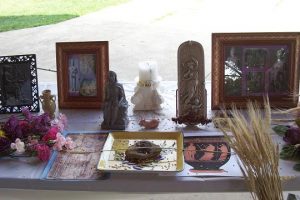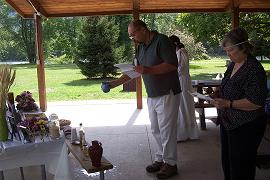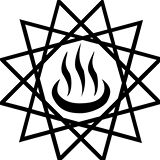by Gitana edited by Melissa
(15-21 Boedromion) The Eleusinian Mysteries (Eleusinia ta megala), honoring Demeter and her daughter Persephone, were the most popular of the mystery cults. They lasted for a week, and were held in the town of Eleusis, just outside Athens. Any person who spoke Greek was allowed to take part.
All initiates of the cult, which lasted until the 4th century AD, were sworn to secrecy. Our attempts to reconstruct what happened are educated guesses at best. Scholars believe it to be similar to the following: The first day involved bathing in the sea, perhaps even with one’s sacrificial piglet (Plutarch, Phoc. 28.6). Over the next few days the candidates sacrificed the pigs to Demeter and Persephone, prepared the kykeon, and processed from Athens to Eleusis (Inscriptiones graecae II 2 1367 6). Upon their arrival at Eleusis, the candidates were to give a “password” which fortunately helps us to know what was done. It was: “I have fasted, drunk the kykeon, taken things out of the big basket and, after performing a rite, put them in the little basket, whence I put them back in the big basket” (Clement of Alexandria Protrepticus II.21). After this, candidates would throw piglets into a trench (Kevin Clinton, “The Sacturary of Demeter and Kore at Eleusis,” in Greek Sanctuaries: New Perspectives, ed. N. Marinatos and R. Hagg, Routledge, New York, 1993, p. 118), and then imitate Demeter by searching the grounds for Persephone (Plutarch, fragment 178). After this, they would enter the initiation hall, called the Telesterion.

It is within the telesterion that the real mystery took place. The only accounts we have are from late Christian sources. We are told by Clement of Alexandria that some of the offerings were cakes, poppies, pomegranates, figs, fennel, and ivy (Clement of Alexandria, Protrepticus II.22). Concerning what was shown to the initiates we hear different accounts. Tertullian says it was “an image of the male organ” (Tertullian, Against the Valentinians, 1). However, Hippolytus, a Gnostic, tells us that it is an ear of grain that is revealed to the initiates. It is difficult to know for sure. It is at this point that a vision of Persephone herself, surrounded by a blinding light, is thought to appear from inside a small room in the building, known as the anaktoron. Plutarch says that an initiate, when he has “beheld a great light, as when the anaktoron opens, changes his behavior and falls silent and wonders” (Plutarch, De profectu in virtute 81). The next day there are dances, and sacrifices of piglets and a large bull, which were then served at a grand feast. Following that, two large vessels, called plemokhoi were filled with liquid. One faced East and the other West. They were overturned, as a libation, while the priest called out “Hye kye!” which means, “Rain conceive!” (Hippolytus, Refutation of All Heresies, V.7.34). This was the final ritual of the festival.
Even if our assessment of the Eleusinian Mysteries is correct, we cannot truly understand them without participating in them. Aristotle wrote, “Initiates do not need to understand anything; rather, they undergo an experience and a disposition – become, that is, deserving” (Aristotle, in Synesius, Dio, 10). Another ancient writer, Sophocles, said, “Thrice blessed of mortals are those who go to Hades after beholding these rites. To them alone it is given to live there; to others everything there is evil” (Sophocles, in Plutarch, How to Study Poetry, 21f).

The initiates of the Mysteries, through their participation, became the blessed of the Goddesses. Many of us today also wish to take part in these magnificent rituals. Although the tradition has not survived, several recreations are happening in the US and around the world. You can also create your own rituals to celebrate or observe the festival by libations to the goddesses and reading the Homeric Hymns to Demeter, especially Hymn 2, which gives the account of the kidnapping of Persephone by Hades and the Orphic Hymns to Demeter (Hymns 40 and 41). No matter how we celebrate, it is important to worship the Two Goddesses, to learn that death is not the final end, and to become “thrice blessed.”
Watch the video slideshow of the 2005 ritual by Proto-Demos tes Hagnes Persephones.
Note: Helene P. Foley, in her background article on the Eleusinian Mysteries in her edition of The Homeric Hymn to Demeter (Princeton, 1994), states that “all important rites of Demeter in Attica seem to have been linked (at least loosely) to stages of the agricultural year (p. 71). Moreover, these festivals seem to have a connection with some part of the Homeric Hymn, especially since Eleusis, which was incorporated into Attica, was the site of much of the narrative of the Hymn. Thus the Eleusinian Mysteries are part of the sacred festival cycle of grain in ancient Greece, along with the Proerosia (Oct), the Thesmophoria (also Oct), Haloa (Dec), the Lesser Mysteries (Feb), Thargelia (May) and Skiraphoria (June).
